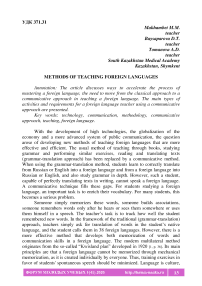Methods of teaching foreign languages
Автор: Makhambet M.M., Baysaparova D.T., Tomanova A.D.
Журнал: Форум молодых ученых @forum-nauka
Статья в выпуске: 1 (41), 2020 года.
Бесплатный доступ
The article discusses ways to accelerate the process of mastering a foreign language, the need to move from the classical approach to a communicative approach in teaching a foreign language. The main types of activities and requirements for a foreign language teacher using a communicative approach are presented.
Technology, communication, methodology, communicative approach, teaching, foreign language
Короткий адрес: https://sciup.org/140287109
IDR: 140287109 | УДК: 371.31
Текст научной статьи Methods of teaching foreign languages
With the development of high technologies, the globalization of the economy and a more advanced system of public communication, the question arose of developing new methods of teaching foreign languages that are more effective and efficient. The usual method of teaching through books, studying grammar and performing similar exercises, reading and translating texts (grammar-translation approach) has been replaced by a communicative method. When using the grammar-translation method, students learn to correctly translate from Russian or English into a foreign language and from a foreign language into Russian or English, and also study grammar in depth. However, such a student, capable of perfectly translating texts in writing, cannot speak a foreign language. A communicative technique fills these gaps. For students studying a foreign language, an important task is to enrich their vocabulary. For many students, this becomes a serious problem.
Someone simply memorizes these words, someone builds associations, someone remembers words only after he hears or sees them somewhere or uses them himself in a speech. The teacher’s task is to track how well the student remembered new words. In the framework of the traditional (grammar-translation) approach, teachers simply ask for translation of words in the student’s native language, and the student calls them in 38 foreign languages. However, there is a more effective method that develops both memorization of words and communication skills in a foreign language. The modern multilateral method originates from the so-called “Kwisland plan” developed in 1920 [1, p. 36]. Its main principles are that a foreign language cannot be memorized through mechanical memorization, as it is created individually by everyone. Thus, training exercises in favor of students' spontaneous speech should be minimized. Language is culture, i.e. cultural knowledge is transmitted in the process of teaching a foreign language through authentic language materials. Each lesson should be built around a single focus, students in one lesson should recognize one distinguished unit of the content of training. Grammar, like the dictionary, is taught in measured portions in a strict logical sequence: each subsequent lesson should increase the existing stock. All four types of speech activity must be present simultaneously in the learning process [2, p. 157]. The training material is presented in long dialogues with subsequent exercises in a question-answer form. As a rule, the texts proposed for studying this method give a good idea of the culture of the country of the language being studied. However, the role of the teacher limits the possibility of creative use of the studied material by students in situations of direct communication with each other. The purpose of such training is to achieve the students an average level of knowledge of a foreign language [3, p. 17]. The teacher never pays attention to errors in speech, as it is believed that this may inhibit their development of speech skills. Active learning is, of course, a priority at the present stage of teaching a foreign language. Indeed, effective management of educational and cognitive activity is possible only when it is based on the active mental activity of students. Teaching a foreign language at a university using innovative technologies involves the introduction of a number of psychological approaches, such as: cognitive, positive, emotional, motivational, optimistic, technological [4, p. 3]. All these approaches are addressed to the personality of the student.
Sources used:
-
1. Volkova N.P. Pedagogy: Textbook. M .: Akademvidav, 2007.616 p.
-
2. Palagutina M.A. Innovative technologies of teaching foreign languages // Problems and prospects for the development of education: Materials of an international scientific conference. T. 1. Perm: Mercury, 2011.S. 156-159.
-
3. Milrud R. P., Maksimova I. R. Modern conceptual principles of communicative teaching of foreign languages // Foreign languages at school. M., 2000. No. 4.
-
4. Pavlovskaya I.Yu. Methods of teaching foreign languages // Overview of modern teaching methods. 2nd ed. SPb .: Publishing House of SPb. University, 2003.S. 3-4.
Список литературы Methods of teaching foreign languages
- Volkova N.P. Pedagogy: Textbook. M.: Akademvidav, 2007.616 p.
- Palagutina M.A. Innovative technologies of teaching foreign languages // Problems and prospects for the development of education: Materials of an international scientific conference. T. 1. Perm: Mercury, 2011.S. 156-159.
- Milrud R. P., Maksimova I. R. Modern conceptual principles of communicative teaching of foreign languages // Foreign languages at school. M., 2000. No. 4.
- Pavlovskaya I.Yu. Methods of teaching foreign languages // Overview of modern teaching methods. 2nd ed. SPb.: Publishing House of SPb. University, 2003.S. 3-4.


